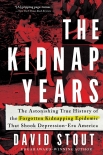The Kidnap Years:, David Stout [readict .txt] 📗

- Author: David Stout
Book online «The Kidnap Years:, David Stout [readict .txt] 📗». Author David Stout
A family’s ordeal might last for hours and end happily. Or it might go on for days, with the relatives knowing that as time passed, hope ebbed. For some people, the ring of the phone or the knock on the door brought heartbreak and bottomless sorrow—the very emotions visited upon the family in Jamestown, New York, in 1974.
There was never much mystery behind the Jamestown case. The instructions for delivering the ransom were simple and unimaginative, giving investigators plenty of time to stake out the drop site and photograph whoever picked up the money. The ransom demand was a mere $15,000, a fraction of what the doctor’s family could have paid.
The amateurish nature of the scheme had caused investigators to suspect early on that the crime was the work of local teenage dim bulbs. Sure enough, teachers at the area high school easily identified the youth who had been photographed picking up the money. He was a supervisor at a teen center where the doctor’s son had said he was going just before he vanished. The voice on a tape-recorded call to the doctor’s home was recognized as that of a nineteen-year-old high school dropout who hung out at the teen center.
When two eighteen-year-olds were arrested, they admitted they’d done something wrong under the guidance of the nineteen-year-old, but they swore they hadn’t signed on for anything that might bring harm to the boy.
Ominously, the nineteen-year-old, in whose home the ransom money was found, kept quiet about the boy’s whereabouts. Searchers combed the snowy woods around Jamestown on Saturday and Sunday until the boy’s body was found lashed to a tree. He had been beaten to death, probably with a metal pipe or a hammer judging by the wounds to his head.
Since the kidnapping and slaying had obviously occurred within New York State, the FBI bowed out, leaving the state prosecutors and courts to mete out justice. The two eighteen-year-olds got off with light punishment. But it was the nineteen-year-old who got the biggest break of all. When he went to trial on kidnapping and murder charges, his lawyer argued that there was insufficient evidence to convict him of murder. After all, no one had seen the suspect with the victim from the time he vanished until his body was found in the woods.
The jurors pronounced themselves hopelessly deadlocked, so a deal was worked out under which the nineteen-year-old pleaded guilty just to kidnapping, which meant a sentence of eight to twenty-five years instead of the twenty-five-to-life term he could have gotten for the murder count alone.
Had I been on the jury, I would have tried to cut through the fog. “Let’s use our common sense,” I would have said. “Of course he killed the kid. If he didn’t, who the hell did?”
But the truth doesn’t always count for much in a courtroom, as some lawyers try to inject reasonable doubt into cases in which there is none.**
Viewing a time in history from the vantage point of the present is a bit like being in an airplane and gazing at the ground from two miles up. It is too easy to miss the trees while looking at the forest. Most of the kidnappings from long ago are little remembered today, but they defined the times as much as bank robberies and speakeasies and panhandling.
They spurred new laws and new law-enforcement techniques, like criminal profiling. They brought out the best qualities in some lawmen, like endless persistence and ingenuity, and the worst in others: carelessness, cruelty, even brutality.
Indirectly, the kidnappings also helped to expose the corruption, the moral rot, that infected city hall and police headquarters in some communities in the 1930s, as shown by the fact that some victims were rescued by gangsters while complacent or corrupt police officers watched from the sidelines. Eventually, public disgust helped to spur reforms as people belatedly realized that the mobsters among them were not just colorful rogues but robbers, parasites, pimps, even killers—the kind of people who made kidnapping profitable.
Some people who survived kidnappings were able to treat their times in captivity as excellent adventures (once they had bathed and changed clothes). But most were emotionally scarred, even if they did not realize it at first. Others were damaged for life.
As the false glitz of the 1920s yielded to the crushing poverty of the 1930s, kidnappings became so frequent in the United States that newspapers could scarcely keep up with them, as evidenced by a front-page article in the New York Times on Tuesday, July 25, 1933. The article reported1 the arrest of several Chicago gangsters for the kidnapping of a St. Paul, Minnesota, beer mogul who had been freed after a ransom payment. The article noted that lawmen expected to link the gang to another Midwest kidnapping. And it alluded to an attempted kidnapping on Long Island.
The article was continued on page 4, a “jump page” in newspaper parlance. There was also an article on page 4 about the kidnappings of an Oklahoma oil tycoon and the son of a politician in Albany, New York. There was a report about a Philadelphia real estate broker who was shot dead in a bungled kidnapping attempt. Finally, there was a list, rather like a scoreboard, of some recent cases in which victims were rescued and suspects were apprehended:
Mrs. E. L. (Zeke) Caress, Los Angeles; Dec. 20, 1930, three in prison for life, twenty-two, and ten years.
Sidney Mann, New York; Oct. 13, 1931; three in prison for life, fifty, and twenty years.
Mrs. Nell Quinlan Donnelly, Kansas City; Dec. 16, 1931; two in prison for life; one for thirty-five years.
Fred de Filippi and Adhemar





Comments (0)